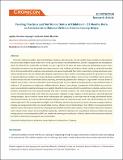| dc.description.abstract | First-time adolescent mothers deal with challenges that place extra demands not only on their stage of adolescent development
but also on their ability to adapt to their new role as a parent. Adolescent and childhood is a period of rapid growth and development.
About 16 million (11%) of all births worldwide are to girls aged 15 to 19 years old. Infant and young child feeding practices have
substantial consequences for the growth, development and survival of infants and children. Infants should be exclusively breastfed
for the first six months of life to achieve optimal growth, development and health. Thereafter, to meet their evolving nutritional needs,
infants should receive safe and nutritionally adequate complementary foods while breastfeeding continues for up to two years of age
or beyond. Adolescent mothers face unique challenges and influences when making a choice on how to feed their infants and most
of them deviate from the recommended infant and young child feeding practices thus leading to a large number of infant deaths of
children born to them. This was a descriptive study whose purpose was to establish the feeding practices and nutritional status of
children 0 - 23 months born to adolescents in Maseno Division, Kisumu County, Kenya. A sample size of 120 children was used. Purposive and accidental sampling techniques were applied. Quantitative data was collected using interview-schedule and observation
checklist. Quantitative data was analysed manually with help of scientific calculator. The study findings might be beneficial to children 0-23 months born to adolescents. There are many studies regarding teenage pregnancy, unsafe abortions, and family planning
among teenagers, but very little is known about what happens after pregnancy, i.e. the experience of teenage motherhood. Results
have been presented in form of text, tables and figures. The prevalence of malnutrition was found to be: 28.3% stunting rate, 23.3%
underweight and 17.5% wasting which was higher than WHO rates. Levels of education, lack of financial income to support child upbringing and inappropriate infant and young feeding practices affected the nutritional status of their children. the recommends that;
adolescent girls who drop out of school due to pregnancies should be enrolled back to school to improve their educational standards
and to enhance their chances of securing better paying jobs, nutritional education and counselling of mothers on infant and young
feeding practices as recommended by WHO and nutritional screening to be conducted to identify children who are malnourished and
put them on malnutrition management as recommended. | en_US |

